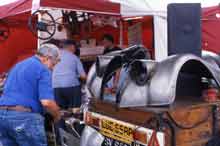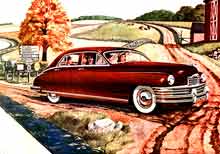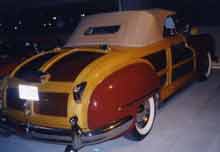Autojumble
You've got to hand it to the Brits. They've come up with an elegant word to describe what we call an "old car, rusty metal and automobilia flea market." Coined by former National Motor Museum director Michael Ware, "autojumble," derived from "jumble sale," the British equivalent of rummage sale, rolls all those meanings into a single word.
Held each year the second weekend in September, Autojumble takes place on the grounds of the National Motor Museum in Beaulieu (say Byoo-lee), Hampshire. Combining elements of Hershey, Carlisle and Chickasha, Autojumble brings together some 1,000 vendors and 40,000 visitors, all on a compact 17-acre site that one can cover in a weekend.
Autojumble is, naturally, strong on British cars and parts, but not exclusively, so whether you need an engine for your Austin 7 or Lagonda or Horstman or Fiat, you can find it at Beaulieu. If you long for the more exotic, how about a V8 Curtiss aero engine? A transmission for your MG or parts for your De Dion are all within reach. There are Bentleys large and small, and even a Lancia Augusta that might have been driven by Tazio Nuvolari (or maybe not).
There's automobilia galore, including luggage, picnic sets and acres of gleaming brass.
Beaulieu's Automart is their version of a car corral, replete with elegant cars like a Rolls-Royce 20 hp doctor's coupe, a charming Amilcar or a rare Australian Chevy with "sloper" body by Holdens of Adelaide. The more adventurous might like this Jaguar 3.4 Mk 2, complete with vintage cigarette butts in the ashtray. In the Automart interesting things can happen, such as this demonstration of why Wolseleys were furnished with starting handles.
Bonhams hold an auction during Autojumble weekend. This year, the cars were as varied as a 1910 Austin 18/24 Endcliffe tourer (£41,100 with buyer's premium), a 1931 Mathis PY coupe (£1,265) and at the low end a browbeaten Humber Super Snipe for £250. My favorite was the 1929 Singer Junior delivery van, that went for £5,750. But since cars and parts are difficult to pack in one's suitcase, I followed the lead of my friend, journalist Mike Worthington-Williams, and concentrated on literature.
The organizers of Beaulieu Autojumble take pains to make the weekend visitor- and vendor-friendly. To guard against mud in rainy weather there are "plastic roads," there are food concessions offering ice cream to noodles, there's a free tent for leaving heavy parts (and free truck transport to your car when it's time to take them home). They even have classic toilets.
Serious autojumblers can sign up for a tour to Hershey. The 2006 Autojumble will take place on September 9th and 10th. Book your B&B now.



